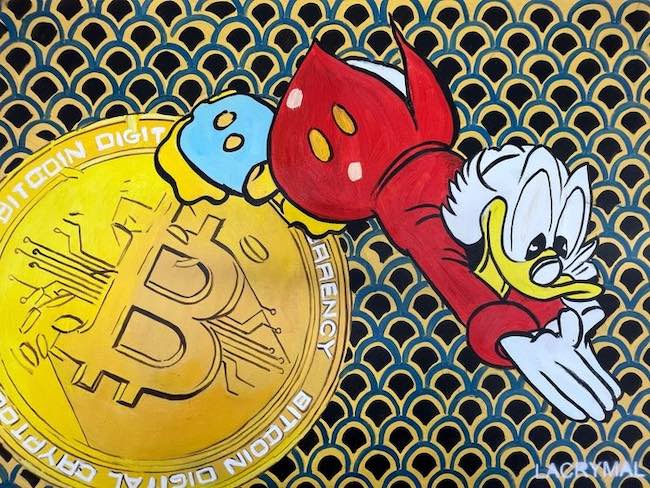Molto spesso l’unico modo per compiere un’osservazione sagace e approfondita del mondo contemporaneo è proprio quella che sceglie la via dell’ironia, dello scherno di tutte le debolezze e piccole manie che appartengono all’essere umano di questo secolo, anche perché sono proprio il sorriso e la semplicità espressiva, dunque la leggerezza formale, a indurre l’osservatore ad avvicinarsi in maniera spontanea senza alzare alcun tipo di barriera razionale e solo in un secondo momento indugiare su tutto ciò che dietro quell’apparente superficialità si nasconde. L’artista di cui vi racconterò oggi sceglie l’approccio più ludico, divertito e a volte irriverente, per effettuare un approfondimento nei confronti degli aspetti evidenti del vivere attuale che però celano un’incapacità di dare rilevanza all’essenza per soffermarsi sulla forma.
Intorno alla metà del Ventesimo secolo cominciò a emergere una nuova classe borghese che sebbene non avesse la preparazione e la cultura per avvicinarsi all’arte né per comprendere quella più intellettuale e concettuale che aveva contraddistinto le rivoluzioni degli anni precedenti, e tantomeno aveva i mezzi per potersi permettere l’acquisto di un’opera originale di un maestro della pittura, aveva però una discreta capacità economica che gli permetteva di desiderare di poter far entrare l’arte nelle loro case. Fu così che il genio del Novecento che risponde al nome di Andy Warhol, decise di dar vita a un nuovo stile artistico dove il messaggio fosse figurativo e molto semplificato e si riferisse a simboli e icone nuove, conosciute e familiari, dove al contempo il costo di un’opera potesse essere alla portata di quella nuova borghesia a cui voleva arrivare. La Pop Art, così definita in quanto si rivolgeva appunto al popolo, alle persone che ogni giorno andavano al supermercato e compravano i simboli del consumo, o al cinema per vedere i film delle dive di Hollywood, o acquistavano dischi delle pop star del momento, o ancora si appassionavano ai fumetti, attraverso una figurazione semplificata e molto colorata, aprì la strada alle opere riprodotte in serie numerate e all’utilizzo della serigrafia come nuovo supporto espressivo. La vita della Pop Art, di cui furono emblemi oltre a Warhol anche Roy Liechtenstein e James Rosenquist, si mescolò inevitabilmente con quello della Street Art, nata poco dopo con intento completamente differente dunque per gridare la rabbia degli artisti invisibili ed emarginati nelle periferie delle grandi metropoli, ma di fatto con lo stesso scopo comunicativo, quello cioè di parlare un linguaggio chiaro che chiunque riuscisse a comprendere, mentre era in coda per andare al lavoro o mentre volgeva lo sguardo verso i muri degli anonimi palazzi lontani dalle luci della città. Andy Warhol non fu solo artista bensì anche mecenate dei protagonisti della Street Art newyorkese degli anni Ottanta, dunque nella sua Factory accolse in pianta stabile Jean-Michel Basquiat e Keith Haring che in qualche modo aprirono la strada alla successiva contaminazione, quella che si evolse nell’attuale Graffitismo dove i riferimenti popolari si mescolano con i messaggi esistenziali e a volte politici della Street Art, ormai entrata di diritto nelle più importanti gallerie. Ma la Pop Art segnò anche l’inizio della sperimentazione di materiali differenti, dell’utilizzo della tecnica mista, dell’apporto del collage, come nel caso del britannico Richard Hamilton, dove i ritagli riprendevano dettagli e simboli di quella società assoggettata al consumismo che da un lato rendeva la vita più piacevole ma dall’altro di fatto cominciava a inaridirla.
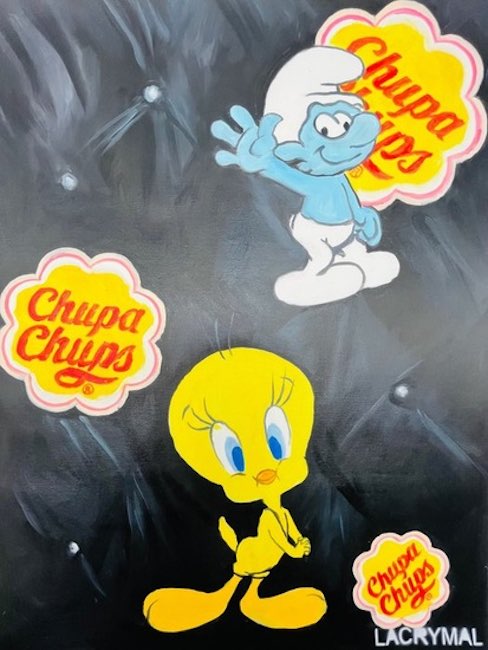
L’artista francese Lacrymal, la cui identità è anonima, mescola la Pop Art e la Street Art, poiché ha mosso i primi passi proprio eseguendo graffiti sui muri del quartiere parigino di Aubervilliers dove è nato e cresciuto, attraverso una sovrapposizione di immagini assemblate e stampate attraverso il computer su cui poi agisce con acrilico per definire gli sfondi o i personaggi che desidera rendere protagonisti delle sue opere; attualmente la sua produzione artistica esplora il campo dei fumetti ma anche quello dei simboli degli anni più recenti a cui associa sempre le grandi firme del lusso, quasi volesse sottolineare un’evoluzione dei prodotti desiderati compiuta dagli anni Cinquanta del Novecento a oggi perché laddove in precedenza l’obiettivo sociale era di dare l’opportunità a tutti di accedere al benessere emergente, nell’attualità ciò che sembra contare di più è il possedere, come se potersi permettere l’acquisto di un bene di lusso fosse un obiettivo principale per sottolineare il proprio status quo.
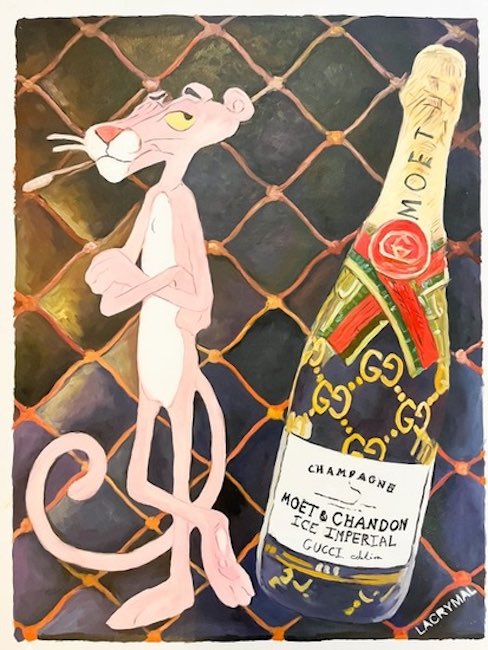
Ed è proprio in questo falso obiettivo che Lacrymal mostra il suo lato più ironico e impertinente, ponendo accanto ai marchi più celebri personaggi dei fumetti che hanno accompagnato l’infanzia dei ragazzi degli anni Ottanta e Novanta, come la Pantera Rosa, in canarino Titti, i Flinstones, quasi fossero in grado con la loro presenza di ridimensionare l’importanza normalmente data al lusso, come se volessero sdrammatizzare con la loro decontestualizzazione tutto l’arrivismo della società contemporanea.
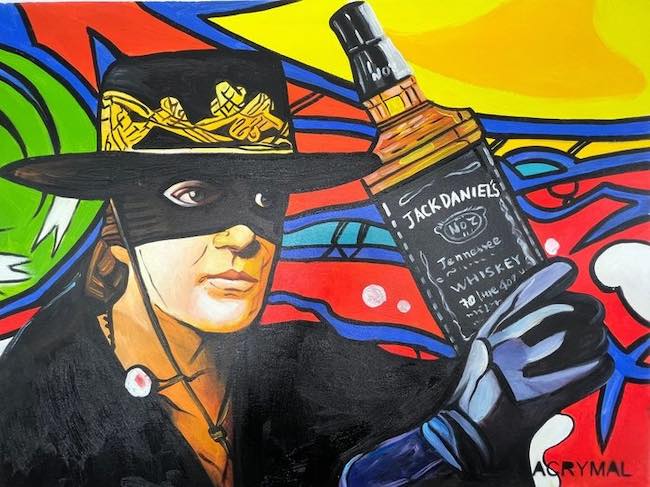
Non solo, Lacrymal rappresenta in modo derisorio anche la serietà di alcune icone del passato come Zorro o Mary Poppins, a volte persino si insinua nell’arte dei secoli precedenti e ne estrae i protagonisti per collocarli in un contesto completamente diverso, improbabile, attraverso cui sottolinea quanto il valore di un dipinto sia assoggettato ormai solo alle leggi di mercato.
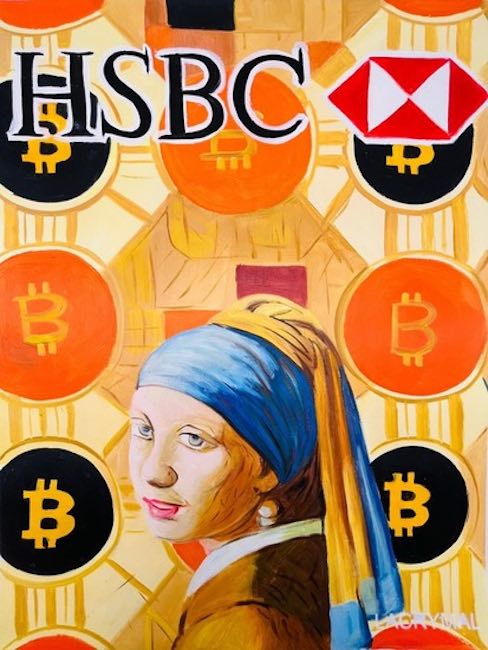
Questo è esattamente il caso dell’opera Art Value, dove il volto della Ragazza con l’orecchino di perla di Jan Vermeer è estrapolato dal contesto originario e riprodotto su uno sfondo pieno di simboli dei Bitcoin, l’attuale moneta virtuale che non esiste materialmente pur avendo assunto uno straordinario potere di acquisto; qui l’artista intende forse sottolineare quanto tutto possa divenire effimero, persino il denaro, a differenza dell’arte, quella con la A maiuscola, che riesce a mantenere intatta la sua bellezza e il suo valore a dispetto del cambiamento dei tempi o delle abitudini consumistiche.

In Porsche style invece lo sfondo che sembra riprodurre il colore degli interni in pelle della lussuosa automobile fa da base alla presenza di Mister Monopoli, la ricchissima mascotte del gioco conosciuto in tutto il mondo, e a quella di Fred Flintstone che con il suo preistorico mezzo di locomozione con spinta a piedi forse era più felice e soddisfatto di qualunque facoltoso uomo moderno in grado di permettersi una sfarzosa e costosa macchina. Il preistorico sembra infatti deridere quell’inseguimento verso l’ostentazione che invece è obiettivo del ricchissimo Mister Monopoli, come se lui conoscesse il segreto della felicità che non può essere raggiunta con ciò che si possiede, piuttosto con ciò che si è.
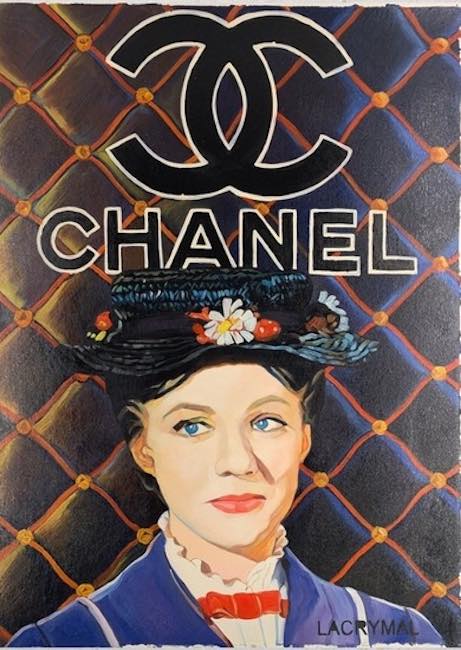
Ma Lacrymal non si limita a rendere protagonisti i personaggi dei fumetti, mette in risalto anche volti dei personaggi del cinema associandoli a simboli che mai, nei ruoli da loro interpretati, penserebbero di avvicinare, come Julie Andrews nel ruolo di Mary Poppins che viene posta sotto il marchio di Chanel, frivolezza a cui un’istitutrice non si sarebbe mai lasciata andare; eppure, nella tentazione della modernità e della possibilità di ricchezza, sembra suggerire l’artista, nessuno può resistere a quella bellezza costosa generata dal bene della moda e che diviene un simbolo di uno stato sociale a cui tutti sembrano anelare. Tutti tranne i dissidenti, i ribelli, quelli che preferiscono la sostanza alla forma e che, come lui, riescono a vedere con lucidità la direzione verso cui la società si sta spingendo.
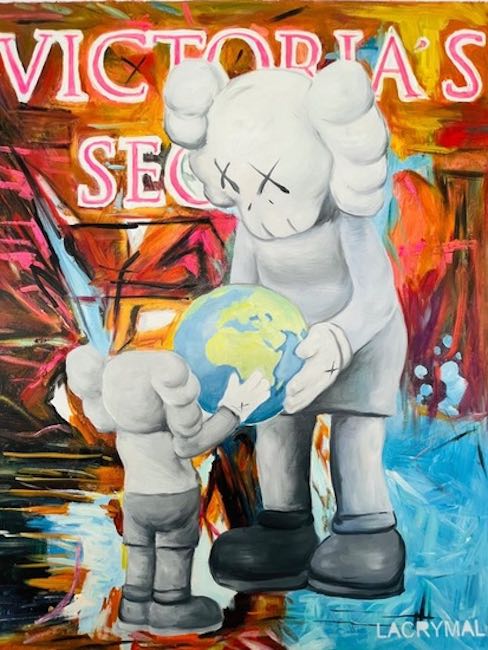
Nell’opera Earth Gift invece, Lacrymal omaggia il collega Kaws e rende protagonista uno dei suoi Companions affidando al pupazzo, declinato al femminile, il compito di mettere il globo terrestre nelle mani di una bambina, intesa come nuova generazione, nella speranza che ne sappia fare un uso migliore di quanto ne ha fatto, e ne sta facendo, la generazione attuale. L’icona consumistica di Victoria’s secret in questa tela è quasi completamente coperta dalla testa del pupazzo, come se all’interno della tela si celasse il suggerimento che in fondo esiste ancora, un modo, una possibilità di offuscare la superficialità e di modificare la scala di valori per costruire un mondo migliore, più vero, più orientato alla virtuosità, più vicini all’anima e all’interiorità che non all’effimero. Lacrymal è attualmente collezionato in tutto il mondo, è rappresentato da molte gallerie e le sue opere sono regolarmente battute all’asta.
LACRYMAL-CONTATTI
Sito web:
www.barnebys.it/aste/lotto/lacrymal-1990-basquiat-lwnnsdqku2
www.lot-art.com/auction-search?q=lacrymal§ion=1&cat=&country=
Luxury icons and the world of comics in Lacrymal’s Pop Art, analysing the consumerist society of the third millennium
Very often, the only way to make a shrewd and in-depth observation of the contemporary world is by choosing the path of irony, of mocking all the weaknesses and little foibles that belong to the human being of this century, also because it is precisely the smile and expressive simplicity, hence formal lightness, that induce the observer to approach it spontaneously without raising any kind of rational barrier, and only later to linger on all that is hidden behind that apparent superficiality. The artist I am going to tell you about today chooses the most playful, amused and sometimes irreverent approach to investigate the obvious aspects of current life that, however, conceal an inability to give relevance to the essence in order to dwell on the form.
Around the middle of the 20th century, a new bourgeois class began to emerge that although it did not have the preparation and culture to approach art nor to understand the more intellectual and conceptual styles that had characterised the revolutions of the previous years, nor had the means to afford the purchase of an original artwork by a master painter, it did have a discrete economic capacity that allowed it to wish to bring art into their homes. So it was that the 20th century genius who answers to the name of Andy Warhol, decided to give life to a new artistic style where the message was figurative and very simplified and referred to new, familiar and familiar symbols and icons, where at the same time the cost of a work could be affordable for the new middle class he wanted to reach. Pop Art, so defined because it addressed the people, the ones who every day went to the supermarket and bought the symbols of consumption, or went to the cinema to see the films of Hollywood divas, or bought records of the pop stars of the moment, or even got hooked on comic strips, through a simplified and very colourful figuration, opened the way to artworks reproduced in numbered series and to the use of silk-screen printing as a new expressive medium.
The life of Pop Art, of which, apart from Warhol, also Roy Liechtenstein and James Rosenquist were emblems, inevitably mingled with that of Street Art, which came into being shortly afterwards with completely different intentions, so to cry out the anger of the invisible and marginalised artists on the outskirts of the big cities, but in fact with the same communicative purpose, namely to speak a clear language that anyone could understand, while queuing for work or looking at the walls of anonymous buildings far from the city lights. Andy Warhol was not only an artist but also a patron of the protagonists of New York Street Art in the 1980s, and so in his Factory he welcomed on a permanent basis Jean-Michel Basquiat and Keith Haring, who in some ways paved the way for the subsequent contamination that evolved into today’s Graffitism, where popular references are mixed with the existential and sometimes political messages of Street Art, which has now entered the most important galleries by right. But Pop Art also marked the beginning of experimentation with different materials, of the use of mixed media, of the contribution of collage, as in the case of the British artist Richard Hamilton where the cut-outs took up details and symbols of that society subjected to consumerism that on the one hand made life more pleasant but on the other actually began to wither it. The French artist Lacrymal, whose identity is anonymous, mixes Pop Art and Street Art, as he took his first steps by painting graffiti on the walls of the Parisian quarter Aubervilliers where he was born and grew up, through a superimposition of images assembled and printed by computer on which he then works with acrylics to define the backgrounds or characters he wishes to make the protagonists of his artworks; at present, his artistic production explores the field of comic strips, but also that of the symbols of more recent years with which he always associates the big names of luxury, as if he wanted to emphasise an evolution of desired products from the 1950s to the present day, because whereas previously the social objective was to give everyone the opportunity to access emerging wealth, nowadays what seems to count most is possession, as if being able to afford the purchase of a luxury good were a main objective to emphasise one’s status quo.
And it is precisely in this false objective that Lacrymal shows its most ironic and impertinent side, placing next to the most famous brands comic strip characters that accompanied the childhood of children in the 1980s and 1990s, such as the Pink Panther, Tweety the Canary and the Flintstones, almost as if by their presence they were able to downplay the importance normally given to luxury, as if they wanted to lighten up all the careerism of contemporary society with their decontextualisation. Not only that, Lacrymal also derisively depicts the seriousness of certain icons of the past such as Zorro or Mary Poppins, sometimes even insinuating himself into the art of previous centuries and extracting its protagonists to place them in a completely different, improbable context, through which he emphasises how the value of a painting is now subject only to the laws of the market. This is exactly the case in the painting Art Value, where the face of Jan Vermeer‘s Girl with a Pearl Earring is extrapolated from its original context and reproduced on a background full of Bitcoin symbols, the present virtual currency that does not materially exist even though it has taken on extraordinary purchasing power; here, the artist perhaps intends to emphasise how ephemeral everything can become, even money, unlike art, the art with a capital A which manages to retain its beauty and value in spite of changing times or consumer habits. In Porsche style, on the other hand, the background that seems to reproduce the colour of the leather interior of the luxurious car is the basis for the presence of Mister Monopoly, the very rich mascot of the world-famous game, and that of Fred Flintstone who, with his prehistoric means of locomotion with foot-propulsion, was perhaps happier and more satisfied than any wealthy modern man able to afford a sumptuous and expensive car. Indeed, the prehistoric man seems to mock that pursuit of ostentation that is the goal of the very rich Mr. Monopoly, as if he knew the secret of happiness that cannot be achieved with what one possesses, rather with what one is.
But Lacrymal does not limit himself to making comic book characters the protagonists, he also highlights faces of film characters by associating them with symbols that they would never, in the roles they play, think of approaching, such as Julie Andrews in the role of Mary Poppins who is placed under the Chanel label, a frivolity that a governess would never indulge in; and yet, in the temptation of modernity and the possibility of wealth, the artist seems to suggest, no one can resist that expensive beauty generated by the good of fashion and which becomes a symbol of a social status that everyone seems to yearn for. All except the dissidents, the rebels, those who prefer substance to form and who, like him, can clearly see the direction in which society is heading. In Earth Gift, on the other hand, Lacrymal pays homage to his colleague Kaws and makes one of his Companions the protagonist by entrusting the puppet, in the form of a woman, with the task of placing the globe in the hands of a little girl, understood as a new generation, in the hope that she will be able to make better use of it than the current generation has done, and is doing. The consumerist icon of Victoria’s secret in this canvas is almost completely covered by the head of the puppet, as if within the canvas is concealed the suggestion that after all there still exists a way, a possibility of blurring superficiality and changing the scale of values in order to build a better, truer, more virtue-oriented world, closer to the soul and interiority than to the ephemeral. Lacrymal is currently collected worldwide, is represented by many galleries and his paintings are regularly auctioned.


